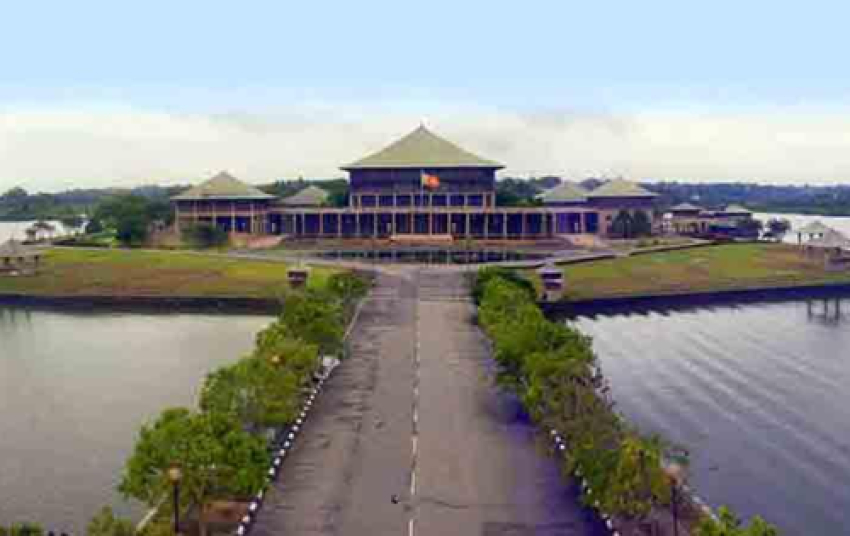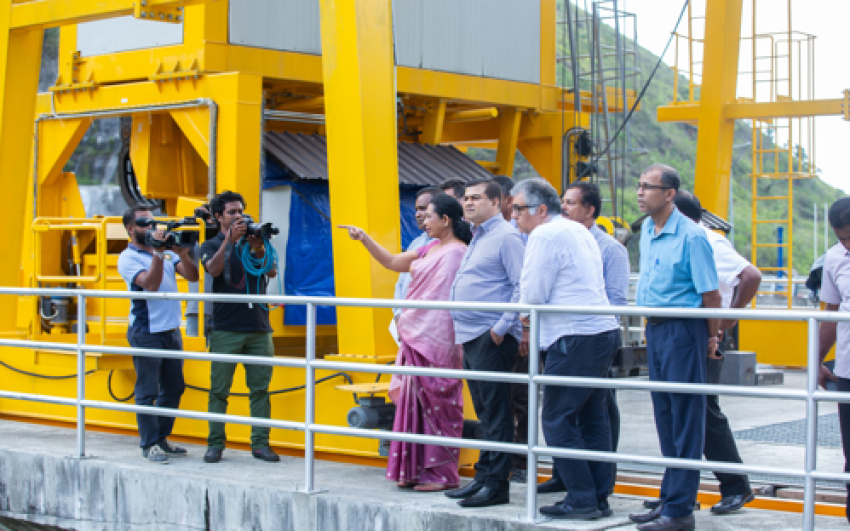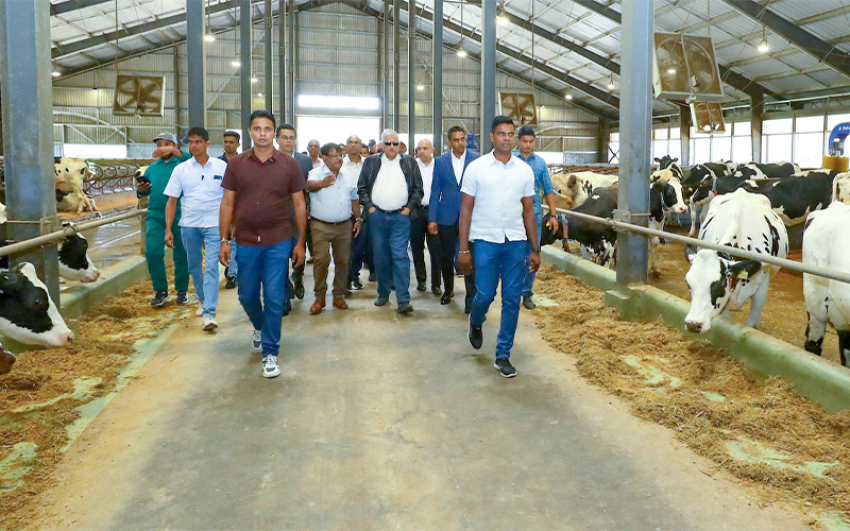As global summer temperatures rise, more buildings are installing energy-hungry air conditioners – a major contributor to climate change. But are there ways to cool buildings down without turning the AC on?
By Martha Henriques
23 August 2019
At first sight, the view could be mistaken for the rolling hummocks of Hobbiton, right down to the perfectly circular doors opening out of the lush green hillside. But the doors are made of glass, and inside them are not cosy hobbit holes but an array of large mechanical steel arms and levers holding some of the doors ajar.
These hills are part of the roof of the California Academy of Sciences in San Francisco, US. The undulating green roof is one of a series of engineering and design features that make the academy one of the largest passively ventilated spaces in the US. This means that even in the peak of summer, the bulk of this building relies on clever manipulation of the elements to stay cool, with next to no air conditioning.
You might also like:
Ten simple ways to act on climate change
The animals that will survive climate change
Could wooden buildings help fight climate change?
Roofs like these are one way that architects, engineers and designers are rethinking buildings to find ways to keep them cool without air conditioning. The challenge is becoming increasingly urgent; it has been yet another scorching year, with heatwaves steamrolling Australia, southern Asia, North America and Europe. To deal with heatwaves, made more frequent by climate change, the number of AC units is expected to more than triple worldwide by 2050. As well as guzzling huge amounts of electricity, AC units contain refrigerants that are potent greenhouse gases. These refrigerants are in fact the fastest-growing source of greenhouse gas emissions in every country on Earth.
But there are alternatives, and plenty of them. From ancient building designs that have been tried and tested over 7,000 years, to the cutting-edge technologies at the California Academy of Sciences, it is possible to create buildings that stay cool with virtually no energy requirements at all.
At the academy, the roof’s grassy domes divert the natural flow of air inside the building. As the wind blows across, one side of the hills is at negative pressure, which helps to suck air through the automatically controlled roof windows and into the building. The fact that the roof is covered with vegetation also helps to bring the temperature down in the space below, as well as providing a habitat for wildlife above.
What about the much more ordinary, everyday buildings that most of us spend the majority of our time in?
“We start off with the attitude of how far can we go in designing the building on the assumption that we’re not going to have AC,” says Alisdair McGregor, global leader for mechanical engineering at Arup, who was involved in the building’s design. But it’s rare to fully climate-control the whole building by that approach, he adds. There might be constraints imposed by a noisy motorway next to a building, making it unfeasible to open the windows. Or the building could have a lot of hot equipment or people with particular needs, such as in a hospital. But at least it means that AC, along with its costs and emissions, is reduced to the bare minimum.
The California Academy of Sciences is a pinnacle in passive design. But it was also an almost half-billion-dollar project with access to some of the best engineers and architects in sustainable development. What about the much more ordinary, everyday buildings that most of us spend the majority of our time in – can passive cooling also make them heatwave-proof?
Water
One of the simplest forms of passive cooling makes use of the temperature change in the air when water evaporates. Water requires energy to go from the liquid state to vapour, and it takes that energy from the air in the form of heat.
“Evaporative cooling is a natural phenomenon,” says Ana Tejero González, an engineer at Valladolid University in northern Spain. “We can see a lot of examples in nature where this happens.” It can cool a surface as well as a body of air, such as your skin when you sweat, or a dog’s tongue when it pants.
In González’s region of Spain, a traditional vessel called a botijo uses the same principle. The botijo is a large pot made of porous clay and used to carry water or wine, which farm labourers would take out into the fields. Small amounts of the drink evaporates through pores in the clay walls, keeping the liquid inside cool even under the hot Spanish sun.
In architecture, the use of evaporative cooling goes back to ancient Egypt and the Romans. But some of the more elaborate examples are from Arabic architecture and a structure called the mashrabiya. A mashrabiya is an ornate, traditionally wooden lattice carved with intricate designs, found on the outside or the inside of a building. As well as providing shade, in the summer the mashrabiya would be home to porous earthenware pots – like the botijo – filled with water. These would help to cool the room as a breeze flowed through the mashrabiya and over the pots.
Even in exposed, hot and arid climates, cooler temperatures are never too far away
But there are even simpler ways to harness evaporative cooling in a building or outside space. A body of water in a courtyard – a pond, fountain or runnels of water flowing throughout the space – all do the same job. And inside, placing an earthenware pot of water near a window or draughty spot can help to cool the place down.
Earth
If currently temperate regions of the global north are going to become equipped to deal with routine extreme heat, there is a lot to be learned from buildings, both ancient and modern, in the global south, says Manit Rastogi, a founding partner at the architectural firm Morphogenesis, based in India. “This part of the world has always been hot,” says Rastogi. Passive cooling systems have been a matter of necessity for thousands of years. “Most of the architecture we’ve done traditionally here are phenomenal examples of achieving cool conditions without mechanical means.”
Even in exposed, hot and arid climates, cooler temperatures are never too far away. In Jaipur, the capital of Rajasthan state in northern India, daytime temperatures regularly reach upwards of 40C in the summer months. But just a few metres below ground, the temperature of the earth in the region remains a much gentler 25C, even through the fiercest summer heat.
The solution is to dig down, says Rastogi, who designed the Pearl Academy of Fashion in Jaipur using this principle. Rastogi and his colleagues used a traditional Indian stepwell, or baoli, within an internal shaded courtyard at the academy. Banks of grey stone steps lead down seamlessly to the edge of a large, still pool of collected rainwater and treated wastewater from the building. The pool, cooled by the subterranean temperatures, absorbs a substantial amount of heat from the courtyard, keeping the air fresh. “Digging into the earth is very, very effective,” says Rastogi.
While it might be an attractive solution, digging an enormous well inside your property isn’t necessary to make use of the same phenomenon. Commercial ground source heating and cooling systems also make use of the earth’s more or less stable year-round temperature by pumping a liquid through buried pipes outside. The liquid’s temperature falls to that of the earth, and is then pumped back inside, where it can run through underfloor pipes to cool the house down. These systems can be used to both heat buildings in winter and to cool them in summer. Global uptake of them for heating has been slow, but they are becoming increasingly popular for cooling, particularly in northern Chinese cities in the summer.
A lot of these strategies are about being in touch with nature and understanding how it works – Manit Rastogi
Besides its baoli, the Pearl Academy of Fashion in Jaipur uses a few other tricks to keep the temperature down. From the outside, the building is a simple rectangular shape, which may not look very elegant but has the benefit of maximising the amount of internal space for external surface area, as every square foot exposed to the Sun absorbs heat. The building is shrouded in a jaali, or perforated stone “skin” about four feet from the outer walls, which helps to shade the building and buffer the temperature. “A lot of these strategies are about being in touch with nature and understanding how it works,” says Rastogi. “Understand the site and that particular typology, and the job will be a lot easier.”
The result is that interior of the academy is a fairly tepid 29C even in the hottest months, when temperatures outside are regularly more than 40C. This allows air conditioning to be used very modestly, when it is necessary at all.
Wind
The city of Yazd in Iran is known as “windcatcher city”. The windcatchers are towers with arched glassless windows sat atop flat-roofed buildings, facing the direction of the prevailing winds. For centuries, these towers have caught the breeze and channelled it down to the dwellings, split into channels by a series of blades within the tower. The arched roof of the windcatcher helps to encourage circulation of air even when there is not a strong breeze blowing. Sometimes the air flows over a basin of water, or even a deep reservoir in a domed chamber, to encourage further cooling.
The windcatchers of Yazd are among the most varied and creative in the Middle East, according to research by Mahnaz Mahmoudi Zarandi, an assistant professor of architecture at the Qazvin Islamic Azad University in Tehran. An analysis of Yazd’s windcatchers found that the most effective models decreased air temperature indoors from 40C to 29.3C.
In ordinary buildings that aren’t fortunate enough to have a windcatcher built in, there are still options, says Arup’s McGregor. Having windows open on different sides of a building at different heights can help to pull air through. “You sometimes see that effect too much, and you almost get a howling gale through,” says McGregor. “For example, a tall atrium with an opening at the top and a door at the bottom. But by varying the openings, you can control the air flow through the building.”
Concrete jungle
Thinking on the scale of individual buildings, however cleverly designed, can only bring the thermostat down so far. But understanding the way that buildings interact with the rest of the urban landscape can help bring it down a notch further.
Even without skyscraper-sized magnifying glasses scorching the pavements, there is the issue of the urban heat island effect
The London skyscraper known as the “walkie-talkie” provides a lesson in how not to do this. The building has one giant concave face. While it might look fancy, there is a reason that inward-curving skyscrapers aren’t very common. Before the building was completed, it was discovered that the vast shiny concave surface acted like a magnifying glass, focusing the Sun’s rays on one small area. That focus happened to be a few metres of pavement outside a hairdresser’s and a Vietnamese restaurant. The result was temperatures so hot that paint melted, car parts blistered and buckled, tiles shattered and a doormat set on fire.
The problem has now been fixed thanks to the addition of a last-minute brise soleil, or giant sunshade made of aluminium slats. But it shows how profoundly a design tweak can alter the temperature of the urban landscape. Even without skyscraper-sized magnifying glasses scorching the pavements, there is the issue of the urban heat island effect – where dull, grey concrete absorbs the Sun’s heat and radiates it back out onto sweltering pedestrians, like a highly unnecessary hot water bottle.
We might think of the heat-island effect as a necessary evil of summer in the city. But urban spaces can be adapted to reduce it. One of the most effective ways is by bringing in some vegetation. We all know this intuitively – it is the difference between the shady tree-lined boulevards of a city like Palma, Majorca, and the blistering exposed sidewalks of New York.
In Medellín, Colombia, the city authorities have been experimenting with “green corridors” through the city. They developed 30 green corridors in otherwise grey parts of the city, making use of the verges of 18 roads and 12 waterways. These green strips lowered temperatures by 2C. A study by Monica Turner, an ecologist at the University of Wisconsin-Madison, showed that even broader tree cover can reduce urban temperatures by up to 5C.
Even in a passively cooled building in a well-designed city, sometimes these design measures are not going to be enough
Many cities are taking similar steps. Milan’s municipal authorities plan to plant three million trees in the city by 2030. Melbourne, Australia, has also begun a tree-planting programme to keep the city liveable through future heatwaves. And new cities, such as China’s Liuzhou Forest City are able to weave in vegetation cover from the start.
Exit strategy
Of course, even in a passively cooled building in a well-designed city, sometimes these design measures are not going to be enough. In a hospital full of heat-generating equipment and vulnerable people, there will be cooling requirements that go beyond what passive systems can achieve. “Here, we don’t care about the energy so much – we just need to achieve the right thermal conditions indoors,” says Valladolid University’s Tejero González.
But the bottom line is that conventional air conditioning should be a last resort, not a crutch. Perhaps the most promising thing about passive cooling, McGregor adds, is that it offers a way out of the vicious cycle we are currently stuck in with air conditioning: using a technology to keep cool that actually contributes to heating the world up.




















